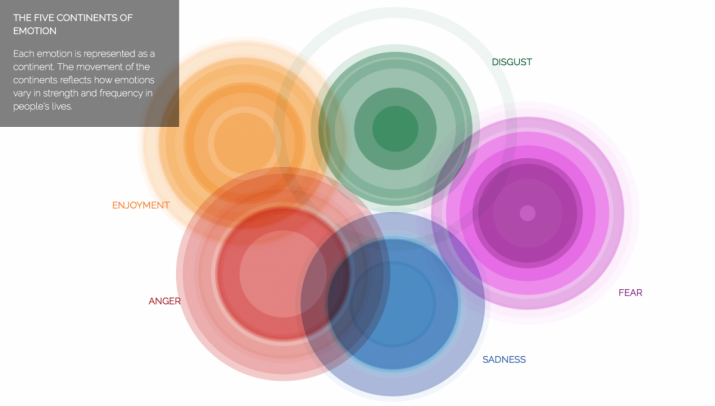NEWS
Dalai Lama Commissions Website to Map Human Emotions
 The Dalai Lama explains his intention with the Atlas of Emotions project. Photo by Tim Gruber. From nytimes.com
The Dalai Lama explains his intention with the Atlas of Emotions project. Photo by Tim Gruber. From nytimes.comIn his unceasing bid to encourage greater self-awareness and compassion among the people of the world, His Holiness the Dalai Lama has commissioned American psychologist Paul Ekman, who is perhaps best known for his work as a consultant on the hit Pixar Animations Studios film Inside Out (2015), to produce what His Holiness refers to as an online “map of the mind.”
The new website, Atlas of Emotions, which was inspired by a series of conversations over several years between the Dalai Lama and his friend Ekman about the science of emotions, is intended as a secular resource where people can learn to understand their moods and feelings through an interactive graphical representation of the human emotional experience and how it influences our lives.
Expressing hope that people would use the website as a tool to help them navigate their inner selves and overcome negative emotions, the Dalai Lama said: “Ultimately, our emotion is the real troublemaker. We have to know the nature of that enemy.” (The New York Times)
While emotions are central to our experience of life—allowing us to experience joy, love, satisfaction, and contentment—many of us often find ourselves at the mercy of our feelings in the way that we react to or are affected by external events, sometimes to the extent that they can negatively color our perception of the world in which we live and the people with whom we interact.
In designing the basis for the online experience of the Atlas, Ekman, a pioneer in the study of emotions and their relation to facial expressions, surveyed 248 emotion scientists, neuroscientists, and psychologists with the intent of establishing something close to a consensus within the inexact science of the nature of emotions and the mental states associated with them. Ekman decided that five broad categories or “continents” of emotions—anger, disgust, enjoyment, fear, and sadness—offered the best representation of the data provided by the survey. These continents can then be navigated in terms of states, actions, triggers, and moods to provide a deeper understanding of where they originate and how they can be understood.
“It is a visualization for what we think has been learned from scientific studies,” said Ekman, emphasizing that the website and its integrated mobile app is a tool for self-examination rather than a scientific work intended for peer review. “It’s a transformative process, a work of explanation.” (The New York Times)
 The Atlas of Emotions. From atlasofemotions.com
The Atlas of Emotions. From atlasofemotions.comSpeaking in Rochester, Minnesota, the Dalai Lama pointed out that the Atlas is deliberately a secular resource. “If we see this research work as relying on religious belief or tradition, then it automatically becomes limited,” His Holiness said. “Even if you pray to God, pray to Buddha, emotionally, very nice, very good. But every problem, we have created. So I think even God or Buddha cannot do much.” (The New York Times)
“We have, by nature or biologically, this destructive emotion, also constructive emotion,” the Dalai Lama said. “This innerness, people should pay more attention to, from kindergarten level up to university level. This is not just for knowledge, but in order to create a happy human being. Happy family, happy community and, finally, happy humanity.” (The New York Times)
See more
Atlas of Emotions
Inner Peace? The Dalai Lama Made a Website for That (The New York Times)
An Atlas of Emotions, Inspired by the Dalai Lama (Citylab)
Buddhistdoor View: Buddhist Dimensions of Inside Out (Buddhistdoor Global)














